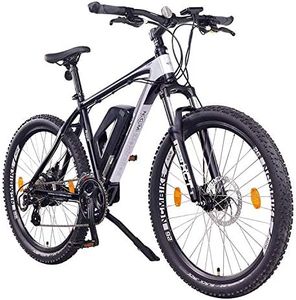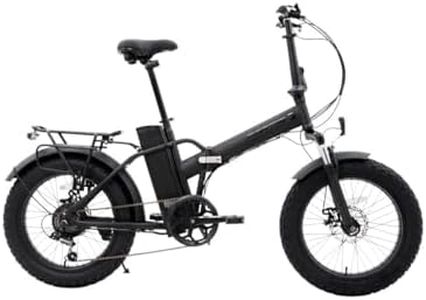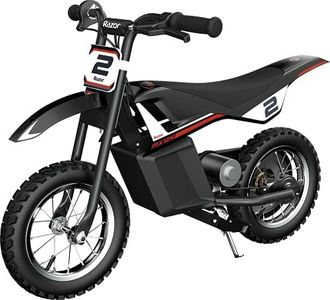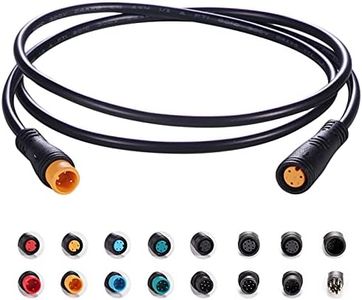We Use CookiesWe use cookies to enhance the security, performance,
functionality and for analytical and promotional activities. By continuing to browse this site you
are agreeing to our privacy policy
10 Best Electric Bikes
From leading brands and best sellers available on the web.Buying Guide for the Best Electric Bikes
When shopping for an electric bike, it's important to understand how different features will affect your riding experience and match your needs. Electric bikes come in many styles and are designed for various uses, from city commuting to off-road adventures. Knowing what you want to use the bike for will help you focus on the specs that matter most. By learning about each key specification, you'll be able to choose an e-bike that feels comfortable, lasts long on a charge, and supports your daily travels.Motor PowerMotor power, usually measured in watts (W), determines how much assistance the bike can give you as you pedal. A higher wattage motor generally means the bike can go faster and handle hills better, but it might also use up the battery more quickly. Low to mid-range motors (250W to 500W) are good for flat city riding and gentle hills, while higher power motors (750W and above) are better for hilly areas, heavier riders, or off-road use. If you're using the bike mostly for city commuting or easy rides, a lower power motor is sufficient. For more demanding terrain or carrying extra weight, consider a stronger motor.
Battery CapacityBattery capacity is measured in watt-hours (Wh) and tells you how far your bike can go on a single charge. A higher Wh number means more range. Batteries around 300Wh can cover short commutes or occasional rides, 400–500Wh suits medium distances, and 600Wh or more is best for long rides or if you use lots of motor power. Pick a battery size based on how far you plan to ride between charges—if you want reliability for longer commutes or adventures, choose a larger battery.
RangeRange is an estimate of how many miles or kilometers you can travel on one battery charge. Real-world range depends on your weight, the terrain, how much you use the motor, and the level of pedal assist. Short ranges (up to 25 miles/40 km) suit short, casual trips. Mid-range (25–50 miles/40–80 km) works well for daily commuting. Long ranges (over 50 miles/80 km) are great if you want to take longer trips without worrying about recharging. Consider your regular travel distances to pick a range that fits your lifestyle.
Frame Type and SizeThe frame type affects comfort and ease of use. Step-through frames are easier to mount and dismount, making them great for city riding or for anyone with limited mobility. Traditional diamond frames offer more rigidity and are better for off-road or sporty riding. Frame size matters for your comfort and safety—smaller sizes suit shorter riders, while larger frames suit taller people. When choosing, make sure the frame matches your height and riding style for the most comfortable fit.
Pedal Assist Levels and ThrottleMany e-bikes offer multiple levels of pedal assist, letting you control how much help you get from the motor. Lower assist levels let you do more of the pedaling and save battery, while higher levels make riding easier, especially uphill. Some e-bikes include a throttle feature, allowing you to ride without pedaling at all. If you want to exercise more, pick a bike with various pedal assist options. If you need a break from pedaling or have mobility concerns, a throttle might be useful.
BrakesBrakes are crucial for safety, especially since e-bikes can be heavier and faster than regular bikes. Common types are rim brakes and disc brakes, with disc brakes (mechanical or hydraulic) offering stronger stopping power, which is important for wet conditions, hilly areas, and high speeds. For basic, flat riding, rim brakes may be enough, but if you ride faster or on more challenging terrain, disc brakes are a safer bet.
Tire Type and SizeTire type and size affect how your bike handles different surfaces. Wide tires (2 inches or more) give extra grip and comfort, perfect for rough roads, gravel, or off-road riding. Narrower tires (less than 2 inches) usually roll faster, making them better for smooth pavement. If your riding is mainly on city streets, slimmer tires work well, but for mixed surfaces or more cushioning, look for wider tires.
WeightE-bikes are heavier than standard bikes because of their motor and battery. The weight affects how easy it is to carry or move the bike, especially if you need to lift it onto a rack or take it up stairs. Lighter e-bikes (under 50 pounds/23 kg) are easier to handle for transport and storage, while heavier bikes feel more stable but can be tricky to move when not riding. Consider your strength and storage situation when picking the weight.










